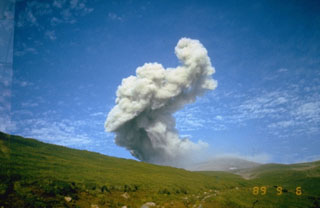Report on Ebeko (Russia) — 20 October-26 October 2021
Smithsonian Institution / US Geological Survey
Weekly Volcanic Activity Report, 20 October-26 October 2021
Managing Editor: Sally Sennert.
Please cite this report as:
Global Volcanism Program, 2021. Report on Ebeko (Russia) (Sennert, S, ed.). Weekly Volcanic Activity Report, 20 October-26 October 2021. Smithsonian Institution and US Geological Survey.
Ebeko
Russia
50.686°N, 156.014°E; summit elev. 1103 m
All times are local (unless otherwise noted)
On 22 October KVERT lowered the Aviation Color Code for Ebeko to Yellow (the second lowest level on a four-color scale), noting that a thermal anomaly over the volcano was last visible on 25 August and eruptive activity had not been recorded since 22 September.
Geological Summary. The flat-topped summit of the central cone of Ebeko volcano, one of the most active in the Kuril Islands, occupies the northern end of Paramushir Island. Three summit craters located along a SSW-NNE line form Ebeko volcano proper, at the northern end of a complex of five volcanic cones. Blocky lava flows extend west from Ebeko and SE from the neighboring Nezametnyi cone. The eastern part of the southern crater contains strong solfataras and a large boiling spring. The central crater is filled by a lake about 20 m deep whose shores are lined with steaming solfataras; the northern crater lies across a narrow, low barrier from the central crater and contains a small, cold crescentic lake. Historical activity, recorded since the late-18th century, has been restricted to small-to-moderate explosive eruptions from the summit craters. Intense fumarolic activity occurs in the summit craters, on the outer flanks of the cone, and in lateral explosion craters.

